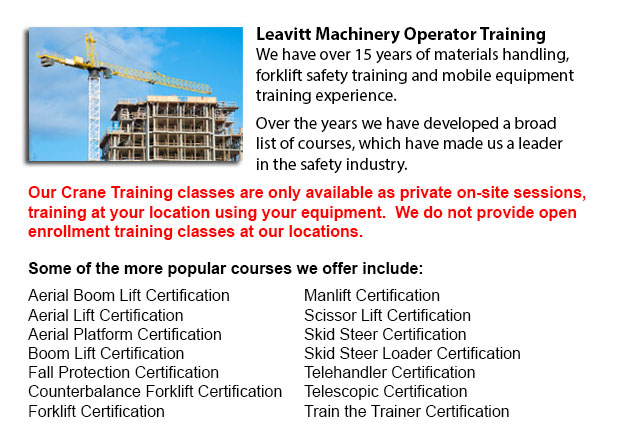
Crane Certification Moose Jaw - The Crane Certification training program includes subject matter suggested by industry regarding the efficient and safe operation of cranes. Individuals training would know the following: how to identify cranes and their component parts; pre-operational, operational and post-operating requirements; rigging components and inspection/rejection criteria; how to determine overall lift capacity; and needs specific to the work place where the individuals training will be operating.
The requirements that need to be done before operating a crane such as assigning authority for the pre-operational check; carrying out the sequential pre-operational check based on the specifications certified by a professional engineer or manufacturer's specifications; checking the log book for comments; checking the work area for hazards and obstacles; inspecting hooks, chains, cables, safety latches and crane movement; ensuring the correct functioning of operational controls; and knowing how to ensure the disconnect switch/isolator of the crane is functioning correctly.
Operational requirements include identifying responsibilities and roles, and determining the requirement for a formal lift plan. Trainees would know how to perform a hazard assessment associated to environmental conditions, physical situations and workers. Subject matter includes determining when to seek competent support, the destination of loads and the safest route, and load weight and centre of gravity.
It is vital for individuals training to be able to identify an over-capacity lift, select correct rigging machine, know load limits, and determine a safe site from which to operate. People training would review both site-specific and universal crane signals for lifts, and techniques for lifting, loading and traveling. Appropriate maintenance practice will be included.
Trainees will be assessed on their understanding of the need for emergency response procedures for different scenarios such as a mechanical or electrical failure. They will be asked to describe parking and shut down procedures for security and safety, to follow tagging and lock out procedures, and to explain why near misses are recorded and reported to the right person. Log book records must be maintained.
The person training would be taught the particulars of rigging, and learn the responsibility and authority for rigging. They would know to identify the various kinds of rigging, storage procedures and the load capacity ratings.
Post-operational requirements comprise entering defects or deficiencies, service and maintenance history within the log book, according to state, provincial and federal codes requirements.
Site-specific needs can be incorporated into the safety training program based on the employer's requirements.
-
Telehandler Training Courses Moose Jaw
Telehandler Training Courses Moose Jaw - Employers are responsible for making sure that their supervisory and operating personnel are trained to work competently making use of telehandler equipment. The competence level of workers need to be assessed... More -
Boom Lift Ticket Moose Jaw
Boom Lift Ticket Moose Jaw - Boom Lifts are a platform lift piece of equipment that could be lifted or lowered to differing heights, making this device a helpful instrument for certain industrial functions. There are some unique types of Boom Lift co... More -
Operator Safety Training, Re-Qualification Training, In-House Instructor Training in Moose Jaw
Utilized in nearly all industrial construction sites, warehouse operations or boat yards, the lift truck is a very important part in order to help lift and transport goods. The reach feature of a lift truck can help better the applications that the l... More -
Heavy Equipment Training Schools Moose Jaw
Heavy Equipment Training Schools Moose Jaw - There are many heavy equipment training schools to choose from. If you want to get to the best, it is important to examine several factors of the school in order to determine the level of education you wil... More -
Counterbalance Forklift Training Moose Jaw
Counterbalance Forklift Training Moose Jaw - Demand is always high for our popular Counterbalance Forklift Truck Training courses. A Counterbalance forklift refers to a forklift along with a weight that counters the balance, enabling the load's weigh... More -
Forklift Training Program Moose Jaw
Forklift Training Program Moose Jaw - Lift trucks are occasionally referred to as jitneys, hi los or lift trucks. These powered industrial trucks are utilized widely today. Department stores used forklifts in order to unload merchandise from trailers... More -
Forklift Ticket Moose Jaw
Forklift Ticket Moose Jaw - Pallet jacks and forklifts are both intended for practically the same reason; to transfer goods from a place of your warehouse to another. This is basically where the comparison stops however. With the pallet jack, the ben... More -
Forklift Operator Certification Moose Jaw
Forklift Operator Certification Moose Jaw - Forklift operator certification is normally needed for employees working in construction, warehouse or industrial setting to guarantee the safe operation of forklifts. Workplace training has to follow a met... More

Forklift Training Moose Jaw
TOLL FREE: 1-888-254-6157
Moose Jaw, Saskatchewan
forklifttrainingmoosejaw.com
Email Us
About Us


